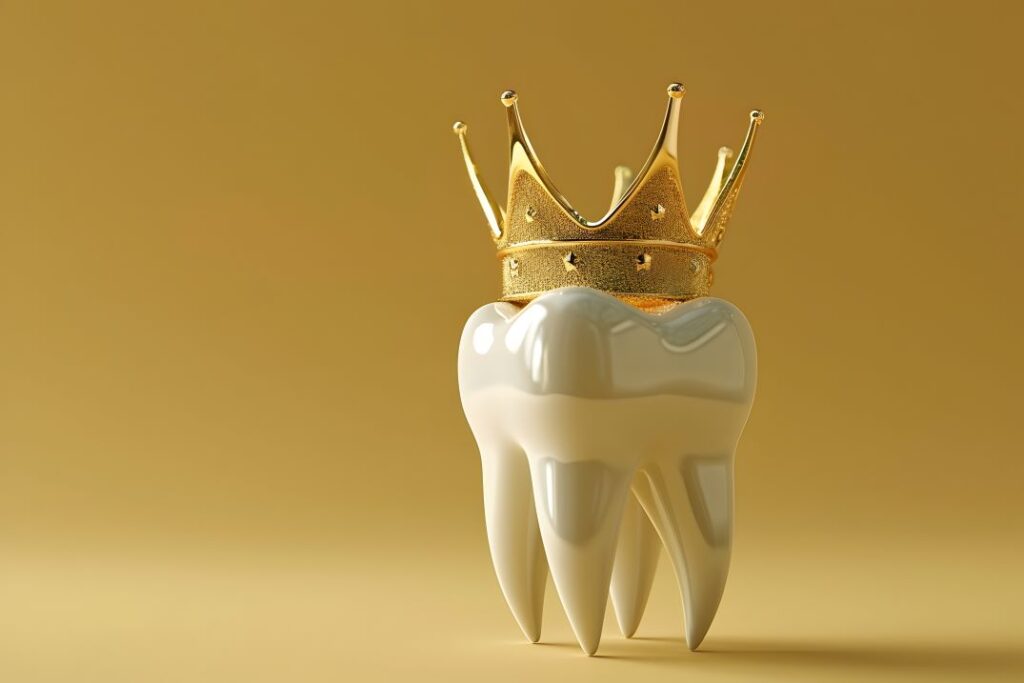Did you know that according to the American Dental Association (ADA) the average person has between three and eight fillings, and that 175 million fillings are made each year? With so many restorations out there, you might think that fillings are always enough intervention to save a damaged tooth. Unfortunately, however, sometimes a traditional filling just isn’t enough, and your tooth may need a restoration called a crown. Think of crowns as deluxe fillings. Though they are different, they still serve the same purpose: to restore the tooth following damage. But that’s where most of their similarities end.

Crowns vs. Fillings: What’s The Difference?
A filling is defined as a material that is bonded inside of a tooth to replace a damaged area of enamel. On the other hand, a crown is a prosthetic device that is cemented in place over the tooth to replace a larger damaged area and restore strength so you can continue to bite with it. The type of repair your dentist chooses depends on several factors.
When Will I Need a Filling?
It can be hard to tell when you’ll need a filling versus a crown, which is why your dentist uses information from X-rays to get a closer look at your teeth. If it is determined that your cavity is minor enough to need just a filling, your dentist will recommend the path of least intervention for that tooth. You can usually get by with a filling if:
- Your tooth has no cracks.
- The area of tooth decay is small.
- Cost is an issue.
Be careful, however, as even though crowns may be more expensive up front than fillings, if you are recommended a crown, it will likely save you money in the long run because the crown will do a better job restoring your tooth. This means you are less likely to need to have more repairs done in the near future, which will save you both time and money.
When Will I Need a Crown?
Crowns cover a much wider area of the tooth, and thus are better for large cavities or for teeth that already have a filling. They are also recommended when:
- Your tooth is cracked.
- Your tooth has become weakened.
- You would like to cover up a mishappen or discolored tooth.
The Benefits of Crowns and Fillings
If you’ve been recommended a filling or crown, the good news is that they both are excellent ways to repair damaged teeth. Both can be done in office by your dentist. Fillings can be done in one visit, while crowns may take two or more appointments: one to take impressions and fit you with a temporary crown, and a second to attach the actual crown after it arrives from the lab.
Both crowns and fillings are made from materials that look natural and can even be shade-matched to the rest of your teeth. You can expect both restorations to last for up to 15 years with proper care and usage, and they can both be brushed and flossed with a normal toothbrush, toothpaste, and dental floss, just like the rest of your teeth.
Whether you need a filling or a crown, you can trust that your dentist has examined your mouth thoroughly and selected the best option to repair your tooth so you can get back to smiling with confidence.
About Our Practice
The team at Goodyear Family Dentistry wants to see you smile. That’s why we place a high emphasis on customer service, and we’ll never recommend a treatment you don’t want or need. We offer a wide range of services to help you keep most of your oral health needs under one roof, from general dentistry to cosmetic dentistry and even dental implants.
If you need a cavity repaired, let our team help determine the best way to fix it. Visit our website or call us at 623-257-7333 today to schedule an appointment.
